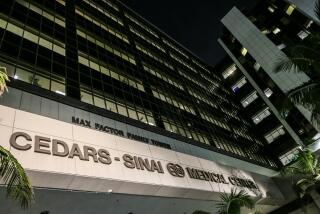Disparity Found in Heart Care for Minorities : Health: UCLA researchers say African Americans, Latinos and Asian Americans are less likely than white patients to receive lifesaving procedures.
- Share via
African Americans in Los Angeles County are only about 60% as likely as whites to undergo heart bypass surgeries and, along with Latinos and Asian Americans, trail white patients in obtaining other lifesaving heart procedures, according to a UCLA study released Tuesday.
The study, which builds on earlier work that showed blacks trail whites in obtaining critical care for heart disease, is believed to be the first study of its kind to measure the access of Asian Americans and Latinos to expensive and sophisticated heart procedures.
UCLA researchers examined hospital discharge records of 131,000 patients who had sought care for chest pains or heart disease between 1986 and 1988. Although the researchers found that the differences are not as great for Latinos and Asian Americans, both groups were also less likely to receive expensive heart procedures than white patients.
Several reasons for the disparity among ethnic groups were cited, including the severity of illness, income, age and the hospital where they were treated.
“It raises questions about what is happening with African Americans,” said Dr. David Carlisle, an assistant professor at the UCLA School of Medicine and lead author of the study, which was published in the American Journal of Public Health. “One possible explanation may be that there are cultural factors that keep them from undergoing this procedure. Another is there is de facto discrimination occurring. We need to find out what is going on.”
The specific hospital turned out to be a critical factor in determining whether they were likely to undergo a heart procedure, authors of the study said.
The researchers said whites tended to go to hospitals that performed a much heavier volume of the three heart procedures studied--angiography, bypass graft surgery and angioplasty--and thus were probably more likely to get them.
African Americans, Latinos, and to a lesser extent, Asians, were more likely to be treated at smaller community hospitals that did not perform cardiac procedures or performed them in smaller numbers. The study did not cite any hospitals by name.
Earlier studies have shown a relationship between income, ethnicity and gender to the type and quality of health care a person receives.
The same studies have also shown that blacks are significantly more likely to suffer and die from sudden heart failure than whites, and that whites, once heart disease is detected, are far more likely to undergo surgery to correct it.
Carlisle said he could not state with a certainty that the disparities led to deaths, but he did say he felt the relatively low number of heart procedures performed on African Americans was “a contributing factor.”
Building on those earlier studies, the UCLA researchers discovered many of the same disparities among Latinos and Asians--although not to the degree experienced by African Americans, who were the least likely to receive treatments in all but one category.
African Americans and Latinos were less likely than whites to undergo each of the three heart procedures studied. Asian Americans were less likely to undergo coronary artery angiography (a diagnostic procedure in which dye is injected into blood vessels) and angioplasty (expanding a balloon inside a blood vessel to crush plaque and open the vessel). But they were just as likely to receive coronary bypass surgery, the most common form of open-heart surgery, in which blood flow to the heart is redirected from clogged arteries through new arteries grafted from other parts of the body.
The study showed that Latinos were half as likely as whites to receive bypass surgery or angiography and about one-third as likely to receive angioplasty. The researchers said that Asian Americans underwent angiography and angioplasty 75% as often as whites.
“Ethnic differences do exist (in the quality of health care received) and they probably are more serious than we thought,” Carlisle said. “Clearly, all minorities don’t experience the same thing when they visit the health care system.”
Dr. Reed V. Tuckson, the president of Charles Drew University School of Medicine in Los Angeles, one of four predominantly black medical schools in the nation, said the findings were simply the latest evidence of the huge disparities that exist in the nation’s health care system.
“It is generally known that African Americans and Latinos and people who are poor do not have access to the coordinated health care system that allows for appropriate continuity of care,” Tuckson said.
He said the poor and people with limited insurance coverage may not be getting referred for more expensive procedures because there is no guarantee of payment. He noted that state and federal financial aid to help pay for the care of the poor is being reduced by hundreds of millions of dollars in California.
Another observer of the health care system, Arnold Torres of the California Hispanic Healthcare Assn., said he hopes the study spurs the state to look at the problem, but added that he is not optimistic.
“There is no shortage of examples of disparity in the health care system,” Torres said. “What we are short of is help and people willing to respond to them in a meaningful fashion.”
More to Read
Sign up for Essential California
The most important California stories and recommendations in your inbox every morning.
You may occasionally receive promotional content from the Los Angeles Times.













